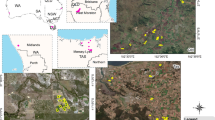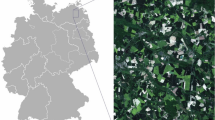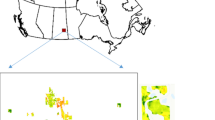Abstract
Remote sensing imagery has been a key data source for precision agriculture. However, high-resolution and/or hyperspectral imagery have typically been favored for their greater information content. This study aims to demonstrate the capability of medium-resolution imagery in precision agriculture by develo** an example of canola yield map** using Sentinel-2 data in central Alberta. Two simple empirical models for map** precision canola yield are tested: one using random forest regression and a second using functional linear regression. Both take as input freely-available Sentinel-2 time series images and use these to predict precision yield gathered by a yield monitor. The models were able to predict crop yield to within 12–16% accuracy of the reference yield. These results also demonstrate that a time series of medium-resolution multispectral imagery can capture small-scale variation in crop yields. The proposed methods can be applied to other areas or crop** systems to improve understanding of crop growth at both the field-level and regional-level.









Similar content being viewed by others
References
Acar-Denizli, N., Delicado, P., Başarır, G., & Caballero, I. (2018). Functional regression on remote sensing data in oceanography. Environmental and Ecological Statistics, 25(2), 277–304.
Bala, S. K., & Islam, A. S. (2009). Correlation between potato yield and MODIS-derived vegetation indices. International Journal of Remote Sensing, 30(10), 2491–2507.
Bauer, M. E., Hixson, M. M., Davis, B. J., & Etheridge, J. B. (1978). Area estimation of crops by digital analysis of Landsat data. Photogrammetric Engineering and Remote Sensing, 44(8), 1033–1043.
Braga, P., Crusiol, L. G. T., Nanni, M. R., Caranhato, A. L. H., Fuhrmann, M. B., Nepomuceno, A. L., & Mertz-Henning, L. M. (2020). Vegetation indices and NIR-SWIR spectral bands as a phenoty** tool for water status determination in soybean. Precision Agriculture, 1–18.
Breiman, L. (2001). Random forests. Machine Learning, 45(1), 5–32.
Chlingaryan, A., Sukkarieh, S., & Whelan, B. (2018). Machine learning approaches for crop yield prediction and nitrogen status estimation in precision agriculture: A review. Computers and Electronics in Agriculture, 151, 61–69.
Courault, D., Hossard, L., Demarez, V., Dechatre, H., Irfan, K., Baghdadi, N., & Ruget, F. (2021). STICS crop model and Sentinel-2 images for monitoring rice growth and yield in the Camargue region. Agronomy for Sustainable Development, 41(4), 1–17.
Delegido, J., Verrelst, J., Meza, C. M., Rivera, J. P., Alonso, L., & Moreno, J. (2013). A red-edge spectral index for remote sensing estimation of green LAI over agroecosystems. European Journal of Agronomy, 46, 42–52.
Doraiswamy, P. C., Hatfield, J. L., Jackson, T. J., Akhmedov, B., Prueger, J., & Stern, A. (2004). Crop condition and yield simulations using Landsat and MODIS. Remote Sensing of Environment, 92(4), 548–559.
Febrero Bande, M., & Oviedo de la Fuente, M. (2012). Statistical computing in functional data analysis: The R package fda.usc. Journal of Statistical Software, 51(4), 1–28.
Fernandez-Beltran, R., Baidar, T., Kang, J., & Pla, F. (2021). Rice-yield prediction with multi-temporal Sentinel-2 data and 3D CNN: A case study in Nepal. Remote Sensing, 13(7), 1391.
Gao, B. C. (1996). NDWI—A normalized difference water index for remote sensing of vegetation liquid water from space. Remote Sensing of Environment, 58(3), 257–266.
Ge, Y., Thomasson, J. A., & Sui, R. (2011). Remote sensing of soil properties in precision agriculture: A review. Frontiers of Earth Science, 5(3), 229–238.
Gómez, D., Salvador, P., Sanz, J., & Casanova, J. L. (2019). Potato yield prediction using machine learning techniques and sentinel 2 data. Remote Sensing, 11(15), 1745.
Herrmann, I., Karnieli, A., Bonfil, D. J., Cohen, Y., & Alchanatis, V. (2010). SWIR-based spectral indices for assessing nitrogen content in potato fields. International Journal of Remote Sensing, 31(19), 5127–5143.
Huete, A. R., Liu, H. Q., Batchily, K. V., & Van Leeuwen, W. J. D. A. (1997). A comparison of vegetation indices over a global set of TM images for EOS-MODIS. Remote Sensing of Environment, 59(3), 440–451.
Hunt, M. L., Blackburn, G. A., Carrasco, L., Redhead, J. W., & Rowland, C. S. (2019). High resolution wheat yield map** using Sentinel-2. Remote Sensing of Environment, 233, 111410.
Jeong, J. H., Resop, J. P., Mueller, N. D., Fleisher, D. H., Yun, K., Butler, E. E., & Kim, S. H. (2016). Random forests for global and regional crop yield predictions. PLoS ONE, 11(6), e0156571.
Karlson, M., Ostwald, M., Bayala, J., Bazié, H. R., Ouedraogo, A. S., Soro, B., Sanou, J., & Reese, H. (2020). The potential of Sentinel-2 for crop production estimation in a smallholder agroforestry landscape, Burkina Faso. Frontiers in Environmental Science, 8, 85.
Kayad, A., Sozzi, M., Gatto, S., Marinello, F., & Pirotti, F. (2019). Monitoring within-field variability of corn yield using Sentinel-2 and machine learning techniques. Remote Sensing, 11(23), 2873.
Kern, A., Barcza, Z., Marjanović, H., Árendás, T., Fodor, N., Bónis, P., & Lichtenberger, J. (2018). Statistical modelling of crop yield in Central Europe using climate data and remote sensing vegetation indices. Agricultural and Forest Meteorology, 260, 300–320.
Khabbazan, S., Vermunt, P., Steele-Dunne, S., Ratering Arntz, L., Marinetti, C., van der Valk, D., & van der Sande, C. (2019). Crop monitoring using Sentinel-1 data: A case study from The Netherlands. Remote Sensing, 11(16), 1887.
Kokoszka, P., & Reimherr, M. (2017). Introduction to functional data analysis. CRC Press.
Liaghat, S., & Balasundram, S. K. (2010). A review: The role of remote sensing in precision agriculture. American Journal of Agricultural and Biological Sciences, 5(1), 50–55.
Liang, L., Di, L., Huang, T., Wang, J., Lin, L., Wang, L., & Yang, M. (2018). Estimation of leaf nitrogen content in wheat using new hyperspectral indices and a random forest regression algorithm. Remote Sensing, 10(12), 1940.
Liu, J., Miller, J. R., Haboudane, D. & Pattey, E. (2004). Exploring the Relationship between Red Edge Parameters and Crop Variables for Precision Agriculture. In Proc. of IEEE International Geoscience and Remote Sensing Symposium (IGARRS), Fairbanks, Alaska, USA, (pp. 1276–1279).
Liu, J., Pattey, E., Miller, J. R., McNairn, H., Smith, A., & Hu, B. (2010). Estimating crop stresses, aboveground dry biomass and yield of corn using multi-temporal optical data combined with a radiation use efficiency model. Remote Sensing of Environment, 114(6), 1167–1177.
Mehdaoui, R., & Anane, M. (2020). Exploitation of the red-edge bands of Sentinel 2 to improve the estimation of durum wheat yield in Grombalia region (Northeastern Tunisia). International Journal of Remote Sensing, 41(23), 8986–9008.
Mkhabela, M. S., Bullock, P., Raj, S., Wang, S., & Yang, Y. (2011). Crop yield forecasting on the Canadian Prairies using MODIS NDVI data. Agricultural and Forest Meteorology, 151(3), 385–393.
Mulla, D. J. (2013). Twenty five years of remote sensing in precision agriculture: Key advances and remaining knowledge gaps. Biosystems Engineering, 114(4), 358–371.
Nguyen, L. H., Joshi, D. R., Clay, D. E., & Henebry, G. M. (2020). Characterizing land cover/land use from multiple years of Landsat and MODIS time series: A novel approach using land surface phenology modeling and random forest classifier. Remote Sensing of Environment, 238, 111017.
Novelli, F., Spiegel, H., Sandén, T., & Vuolo, F. (2019). Assimilation of sentinel-2 leaf area index data into a physically-based crop growth model for yield estimation. Agronomy, 9(5), 255.
Pedregosa, F., Varoquaux, G., Gramfort, A., Michel, V., Thirion, B., Grisel, O., & Vanderplas, J. (2011). Scikit-learn: Machine learning in Python. The Journal of Machine Learning Research, 12, 2825–2830.
Prasad, A. K., Chai, L., Singh, R. P., & Kafatos, M. (2006). Crop yield estimation model for Iowa using remote sensing and surface parameters. International Journal of Applied Earth Observation and Geoinformation, 8(1), 26–33.
Ramsay, J. O., & Silverman, B. W. (2005). Functional data analysis (2nd ed.). Springer.
Rudorff, B. F. T., & Batista, G. T. (1991). Wheat yield estimation at the farm level using TM Landsat and agrometeorological data. International Journal of Remote Sensing, 12, 2477–2484.
Sakamoto, T. (2020). Incorporating environmental variables into a MODIS-based crop yield estimation method for United States corn and soybeans through the use of a random forest regression algorithm. ISPRS Journal of Photogrammetry and Remote Sensing, 160, 208–228.
Salmon, J. M., Friedl, M. A., Frolking, S., Wisser, D., & Douglas, E. M. (2015). Global rain-fed, irrigated, and paddy croplands: A new high resolution map derived from remote sensing, crop inventories and climate data. International Journal of Applied Earth Observation and Geoinformation, 38, 321–334.
Schimmelpfennig, D. (2016). Farm profits and adoption of precision agriculture. United States Department of Agriculture, Economic Research Service. ERR-217.
Segarra, J., González-Torralba, J., Aranjuelo, Í., Araus, J. L., & Kefauver, S. C. (2020). Estimating wheat grain yield using Sentinel-2 imagery and exploring topographic features and rainfall effects on wheat performance in Navarre, Spain. Remote Sensing, 12(14), 2278.
Setiyono, T., Nelson, A., & Holecz, F. (2014). Remote sensing based crop yield monitoring and forecasting. Crop monitoring for improved food security.
Sishodia, R. P., Ray, R. L., & Singh, S. K. (2020). Applications of remote sensing in precision agriculture: A review. Remote Sensing, 12(19), 3136.
Skakun, S., Franch, B., Vermote, E., Roger, J. C., Justice, C., Masek, J., & Murphy, E. (2018). Winter wheat yield assessment using Landsat 8 and Sentinel-2 data. In IGARSS 2018–2018 IEEE International Geoscience and Remote Sensing Symposium (pp. 5964–5967). IEEE.
Skakun, S., Kalecinski, N. I., Brown, M. G., Johnson, D. M., Vermote, E. F., Roger, J. C., & Franch, B. (2021). Assessing within-field corn and soybean yield variability from WorldView-3, planet, Sentinel-2, and landsat 8 satellite imagery. Remote Sensing, 13(5), 872.
Steele, D. (2017). Analysis of precision agriculture adoption & barriers in Western Canada. Retrieved 15 August 2020.
Thenkabail, P. S. (2003). Biophysical and yield information for precision farming from near-real-time and historical Landsat TM images. International Journal of Remote Sensing, 24(14), 2879–2904.
Thorp, K. R., & Tian, L. F. (2004). A review on remote sensing of weeds in agriculture. Precision Agriculture, 5(5), 477–508.
Wang, J., Dai, Q., Shang, J., **, X., Sun, Q., Zhou, G., & Dai, Q. (2019). Field-scale rice yield estimation using Sentinel-1A Synthetic Aperture Radar (SAR) data in coastal saline region of Jiangsu Province, China. Remote Sensing, 11(19), 2274.
Weiss, M., Jacob, F., & Duveiller, G. (2020). Remote sensing for agricultural applications: A meta-review. Remote Sensing of Environment, 236, 111402.
Yu, Q., Tian, Y. Q., Chen, R. F., Liu, A., Gardner, G. B., & Zhu, W. (2010). Functional linear analysis of in situ hyperspectral data for assessing CDOM in rivers. Photogrammetric Engineering & Remote Sensing, 76(10), 1147–1158.
Zhao, K., Popescu, S., & Nelson, R. (2009). Lidar remote sensing of forest biomass: A scale-invariant estimation approach using airborne lasers. Remote Sensing of Environment, 113(1), 182–196.
Zhuo, W., Huang, J., Li, L., Zhang, X., Ma, H., Gao, X., & **ao, X. (2019). Assimilating soil moisture retrieved from Sentinel-1 and Sentinel-2 data into WOFOST model to improve winter wheat yield estimation. Remote Sensing, 11(13), 1618.
Zhou, X., Zhu, X., Dong, Z., & Guo, W. (2016). Estimation of biomass in wheat using random forest regression algorithm and remote sensing data. The Crop Journal, 4(3), 212–219.
Acknowledgements
This research has been made possible by Alberta Canola Producers Commission, Manitoba Canola Growers Association, and Eyes High Postdoctoral Research Program at University of Calgary. We thank the producer who provided us with the precision canola yield dataset and valuable insight into the underlying field-level patterns of yield. We elect not to name them to maintain confidentiality. We also thank Laurel Thompson at Lakeland College in Vermillion, Alberta.
Author information
Authors and Affiliations
Corresponding author
Additional information
Publisher's Note
Springer Nature remains neutral with regard to jurisdictional claims in published maps and institutional affiliations.
Appendix
Appendix
NDVI time series filtering
At any particular location (pixel), let X be a vector containing n values of days-of-year (DOYs) and Y be a vector containing n values of the GEE-retrieved NDVI observed at DOYs in X.
Rule 1 If a large change in NDVI is detected within a searching window of 14 days, a pixel is considered as cloud contaminated.
Let ∆Y be an n x n matrix containing distances between a particular Y value and all values in the Y vector (∆Yi = yi—Y with i indicates a value position in X, Y vectors and a row position in ∆Y). At a random position j, ∆Yj is split into two part: ∆Yj1—distances between yj and Y values to the left of j (start → j), and ∆Yj2—distances between yj and Y values to the right of j position in Y (j → end).
If min(∆Yj1) < − 0.1 & min(∆Yj2) < − 0.1 & (min(∆Yj1) + min(∆Yj2)) < − 0.3, the NDVI observation at j is considered as cloud contaminated.
Rule 2 If a very large change in NDVI is detected between three consecutive valid observations (no matter how far they are from each other in terms of DOY), a pixel is considered as cloud contaminated.
Let x1, x2, x3 be three consecutive DOYs with GEE-filtered NDVI observations—y1, y2, y3.
If (y1−y2) ≥ 0.15 & (y2−y3) ≤ − 0.15 & (y1 + y3) ≥ 0.35, NDVI at x2 is considered as cloud contaminated.
Rights and permissions
About this article
Cite this article
Nguyen, L.H., Robinson, S. & Galpern, P. Medium-resolution multispectral satellite imagery in precision agriculture: map** precision canola (Brassica napus L.) yield using Sentinel-2 time series. Precision Agric 23, 1051–1071 (2022). https://doi.org/10.1007/s11119-022-09874-7
Accepted:
Published:
Issue Date:
DOI: https://doi.org/10.1007/s11119-022-09874-7




